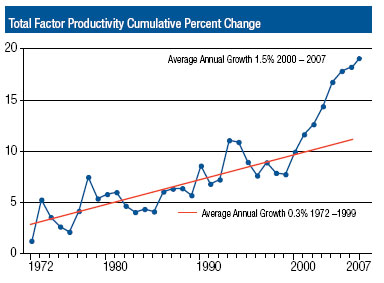Financial Section Part II
Other Expenses
Other operating expenses of $9,333 million for 2007 were 1 million lessthan last year’s comparable amount, as shown in the table that follows.
| Other Operating Expenses | 2007 | 2006 | 2005 |
| (Dollars in millions) | |||
| Supplies and Services | $ 2,594 |
$ 2,643 |
$ 2,557 |
| Depreciation and Amortization | 2,152 |
2,149 |
2,089 |
| Rent and Utilities | 1,700 |
1,721 |
1,590 |
| Vehicle Maintenance Service | 760 |
709 |
586 |
| Information Technology and Communications | 630 |
649 |
652 |
| Rural Carrier Equipment Maint. Allowance | 495 |
485 |
449 |
| Other | 1,002 | 978 | 977 |
| Total Other Operating Expenses | $ 9,333 | $ 9,334 | $ 8,900 |
In 2006, other expenses increased $434 million or 4.9%. The increase was driven by higher fuels costs, which increased both utilities and vehicles maintenance services. The latter category includes the fuels used by our carriers to deliver mail in the community.
Productivity
We use a single indicator to measure productivity, which is called total factor productivity (TFP). TFP measures the change in the relationship between outputs (workload processed) and inputs (resource usage). Workload consists of weighted mail volume, and our expanding delivery network. Resources consist of labor, materials (including transportation), and deployed capital assets. Workload minus resources used equals total factor productivity.
During 2007, TFP improved 1.7%, which is equivalent to $1.2 billion in expense savings. This marks the eighth consecutive year of TFP growth, a cumulative growth of 12.3%, and an overall expense reduction equivalent to $8.2 billion during this time. Productivity gains are a result of effective workforce management, efficient use of material (supplies and services to include transportation), and maximizing the return-on-capital investments (mainly automation). During 2006, TFP grew 0.4%.
The aggregate workload for FY 2007 declined 0.2%. This was mainly due to a sharp decline in weighted mail volume, driven by the 4.7% decline in First-Class single-piece mail volume. Despite the workload decrease, resources were managed effectively, resulting in a 2.5% decline compared to last year.
The following graph shows the TFP cumulative trend from 1971 through 2007.

Service and Performance
Management monitors several key statistics to determine performance against our service standards. The major indicators we monitor are the External First-Class (EXFC) on-time mail delivery scores and the Customer Satisfaction Measurement (CSM) scores.
EXFC is an independently-administered system that provides an external measure of delivery performance from collection box to mailbox. Although not a system-wide measurement of all First-Class Mail performance, EXFC continuously tests a panel of 463 3-digit ZIP Code areas selected on the basis of geographic area and volume density, thereby providing a measure of service performance from the customer’s point of view. In the fourth quarter, we achieved record service scores for all categories. Results of these measures for the last four quarters are listed below.
| EXFC Service Performance Scores |
Quarter 1 | Quarter 2 | Quarter 3 | Quarter 4 |
| (Percentage delivered on time) | ||||
| Overnight Delivery | 95 | 95 | 96 | 96 |
| 2-Day Delivery | 91 | 91 | 93 | 94 |
| 3-Day Delivery | 86 | 88 | 91 | 93 |
CSM is an independently administered survey of customer opinions about key areas of service to residential customers. Customer satisfaction levels remained constant across the last four quarters, which included the implementation of a rate increase in May of 2007. The following table displays the residential satisfaction results for the last four quarters.
| Customer Satisfaction Measurement | Quarter 1 | Quarter 2 | Quarter 3 | Quarter 4 |
| (Percentage) | ||||
| Service rated excellent,very good or good | 92 | 92 | 92 | 92 |
P.L.109-435 mandates that we, in consultation with the PRC, establish a set of “modern service standards” for mailing services within one year after the date of enactment of the law. We have worked with the PRC to finalize the new standards and have issued a Federal Register notice seeking public input on the proposed new standards.

